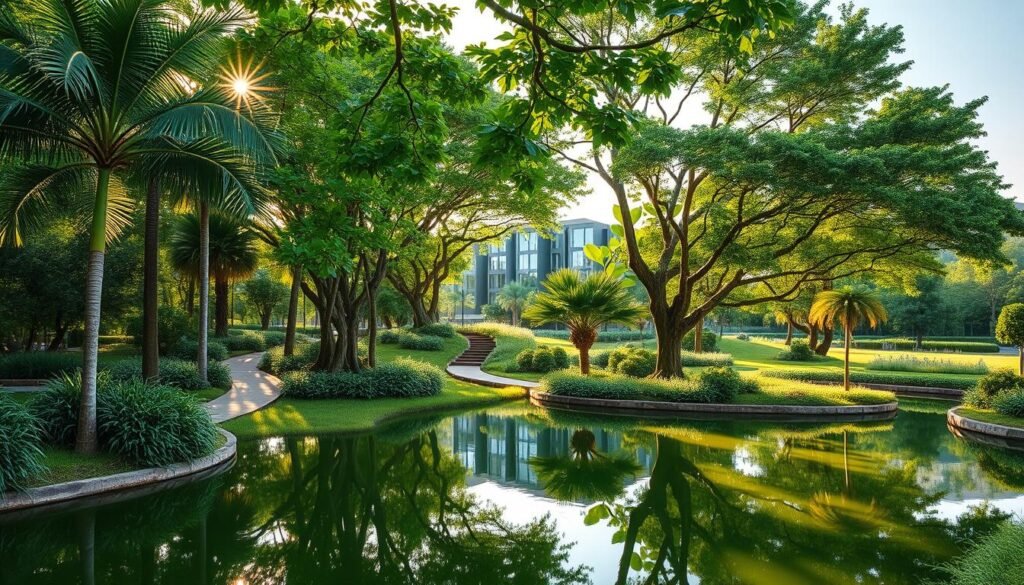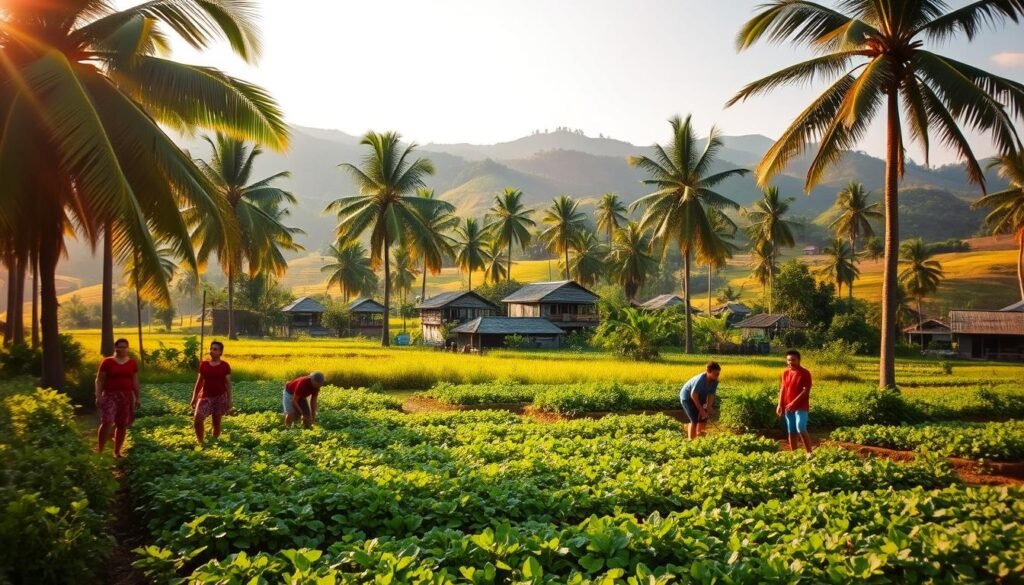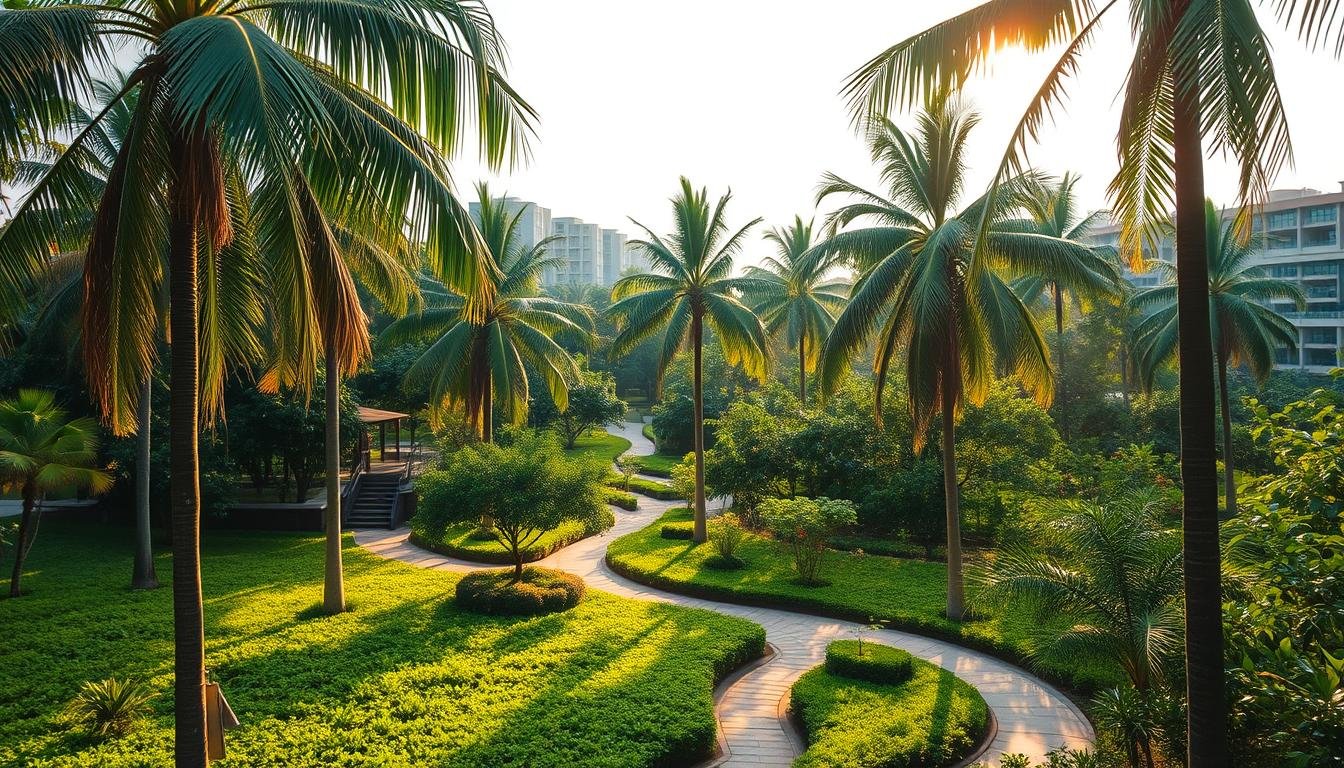When thinking about the future of cities in Cambodia, it’s key to see how green spaces shape them. Recently, Cambodian developers have worked hard to make cities more sustainable and friendly to the environment.
The Bay of Lights project is a big step forward. It’s a 934-hectare area on Sihanoukville’s Ream coast. It won Best Master Plan at the Asia Pacific Property Awards in Bangkok. It focuses on walkability, digital integration, and building a strong community.
Key Takeaways
- Cambodian developers are focusing on sustainable urban development.
- The Bay of Lights project is a notable example of modern master planning.
- Green spaces are key for environmentally friendly cities.
- Community-centered projects improve urban life quality.
- Walkability and digital integration are important in modern developments.
The Evolution of Green Spaces Cambodia: A Development Revolution
Cambodia’s cities are changing fast, thanks to more green spaces and community projects. As cities grow, it’s key to focus on green and community-based development.
Historical Context of Urban Development in Cambodia
Phnom Penh has grown quickly, with 87 public spaces, many with green areas. Yet, the city lacks green spaces in crowded areas.

The Shift Toward Sustainable and Community-Focused Projects
Recently, Cambodia’s real estate has turned to green and community projects. Developers now focus on creating spaces that improve life for locals. This change shows a growing focus on sustainable and community-driven development.
Key Drivers Behind the Green Space Movement
The push for green spaces in Cambodia comes from the government, community needs, and smart urban planning. Developers who add green spaces and community projects see benefits like higher property values and better community ties.
| Key Drivers | Description | Benefits |
|---|---|---|
| Government Initiatives | Policies and regulations supporting green spaces | Increased investment in sustainable development |
| Community Demand | Growing need for community areas and green spaces | Enhanced quality of life for residents |
| Sustainable Urban Planning | Integration of green spaces into urban design | Improved environmental sustainability |
Assessing Community Needs and Environmental Impact
When starting green space projects in Cambodia, it’s key to know what the community needs and how it might affect the environment. The government has made urban greening a priority, seen in plans like the Phnom Penh Green City Strategic Plan (2017-2026). Also, private developers are turning unused areas into green spaces, showing the need to match projects with community needs and the environment.
How to Conduct Effective Community Surveys
Understanding what the local community wants is a big step. To do this, you should:
- Know who you’re surveying and ask questions that fit their needs.
- Ask both numbers and stories to get a full picture.
- Make sure everyone can take the survey, maybe in different languages.
Step-by-Step Environmental Assessment for Developers
Knowing how your project might affect the environment is critical. Here’s how to do it:
- First, look for any environmental risks your project might have.
- Work with local environmental experts to learn more about the area.
- Plan how to lessen any environmental harm your project might cause.

Creating a Balanced Sustainability Plan for Your Project
A good sustainability plan makes sure your green space is good for the environment and the community. To do this, think about:
| Aspect | Community Needs | Environmental Impact |
|---|---|---|
| Surveys and Assessments | Do community surveys to find out what they need. | Do environmental checks to see how it might affect things. |
| Design and Implementation | Make spaces that help people come together. | Use green building methods and materials. |
| Maintenance and Monitoring | Get the community involved in keeping it up. | Watch how it’s doing and change plans if needed. |
By following these steps and making a balanced plan, your green space in Cambodia will be good for both the environment and the community.
Implementing Green Spaces in Your Development Projects
Cambodia’s real estate is moving towards sustainable and community-focused projects. Green spaces are key in these developments. They make the area look better and help the environment and community.
When adding green spaces, think about the local weather and community needs. Choose plants and materials that fit the climate and are cost-effective.
Designing Climate-Appropriate Green Spaces for Cambodia
Creating green spaces for Cambodia means knowing the local weather. Use shade and plants that don’t need much water. This makes upkeep easier.
Key considerations for climate-appropriate design include:
- Use plants native to the area
- Choose water-saving irrigation systems
- Design spaces that stay cool and reduce heat
Selecting and Integrating Indigenous Plants and Materials
Using local plants and materials helps the environment and saves on shipping costs. They’re already adapted to the climate, so they need less care.
Benefits of using indigenous plants and materials include:
- More biodiversity and ecosystem services
- Less upkeep and lower costs
- Respects local culture and environment
Cost-Effective Construction Methods for Sustainable Development
Choosing affordable construction methods is key for green projects. Use local materials, design smart to cut waste, and pick methods that harm the environment less.
| Construction Method | Cost Savings | Environmental Benefit |
|---|---|---|
| Using locally sourced materials | Less money spent on transport | Less carbon emissions |
| Optimizing design to reduce waste | Less waste to throw away | Less waste in landfills |
| Selecting sustainable construction techniques | Long-term savings possible | Less harm to the environment |
By using these strategies, developers can make green spaces that are good for the planet and the community.
Building Community-Centered Features That Add Value
When you’re working on a new project, think about adding community-focused features. In Cambodia, this means making spaces that meet community needs and build a sense of belonging. These areas should also reflect the local culture.
How to Design Multi-Functional Community Areas
Creating spaces that serve many purposes is key. These areas should be able to host markets, events, and social gatherings. Using flexible seating and modular designs makes these spaces more adaptable and easy to use.
Techniques for Creating Spaces That Foster Social Interaction
To encourage people to come together, add features that spark community engagement. Think about public art, communal gardens, and play areas for kids. The goal is to make spaces that bring people closer and foster a sense of community.
Incorporating Cambodian Cultural Elements in Your Design
Adding Cambodian cultural touches makes your project more authentic and appealing. Use traditional architectural styles, local materials, and cultural motifs to connect with the community.
Traditional Architectural Elements Worth Preserving
Khmer architecture is known for stilt houses, intricate carvings, and temple-inspired designs. Including these in your project helps keep Cambodia’s cultural heritage alive.
Modern Interpretations of Cultural Spaces
It’s also vital to update these cultural references for today’s needs. For instance, the Knorng Psar Mountain project mixes traditional Khmer architecture with modern comforts. This creates a unique mix of old and new.
By focusing on community and local culture, your projects become sustainable and meaningful. This approach boosts your project’s value, attracting buyers and benefiting the community.
Conclusion: The Future of Sustainable Development in Cambodia
Cambodia’s economy is growing fast, thanks to more manufacturing, trade, and big projects. This growth means green spaces and community projects will become more important. The country’s cities are set to change a lot, with growth rates over 6% in 2025 and 2026.
You can help shape Cambodia’s future by focusing on sustainable development. This includes green spaces in Cambodia. It makes cities better for the environment and creates places where people can meet and share cultures.
Green spaces and community areas are key to a good city. Looking ahead, green spaces in Cambodia will keep playing a big role. They help the country grow while taking care of the environment.
FAQ
What is the significance of green spaces in Cambodian urban development?
Green spaces are key in shaping Cambodia’s cities. They support sustainable growth and improve life quality for locals.
How can developers assess community needs for green spaces?
Developers can do community surveys to know what locals want. This ensures green spaces meet their needs.
What are the key drivers behind the green space movement in Cambodia?
The green space movement in Cambodia is fueled by environmental awareness, government support, and a focus on community projects.
How can developers design climate-appropriate green spaces in Cambodia?
Developers can design green spaces using local plants and materials. This approach makes spaces sustainable and friendly to the environment.
What are the benefits of incorporating Cambodian cultural elements in development projects?
Adding Cambodian cultural elements makes spaces unique and authentic. It reflects the local culture, improving the project and engaging the community.
What are some cost-effective construction methods for sustainable development?
Developers can use local materials and focus on energy efficiency. This reduces environmental impact and saves costs.
How can community-centered features add value to development projects?
Features like multi-functional areas and spaces for social interaction improve life quality. They make projects more appealing and sustainable.
What is the future of sustainable development in Cambodia?
The future of sustainable development in Cambodia looks bright. It will be driven by more green spaces and community-focused projects, leading to a greener urban landscape.




